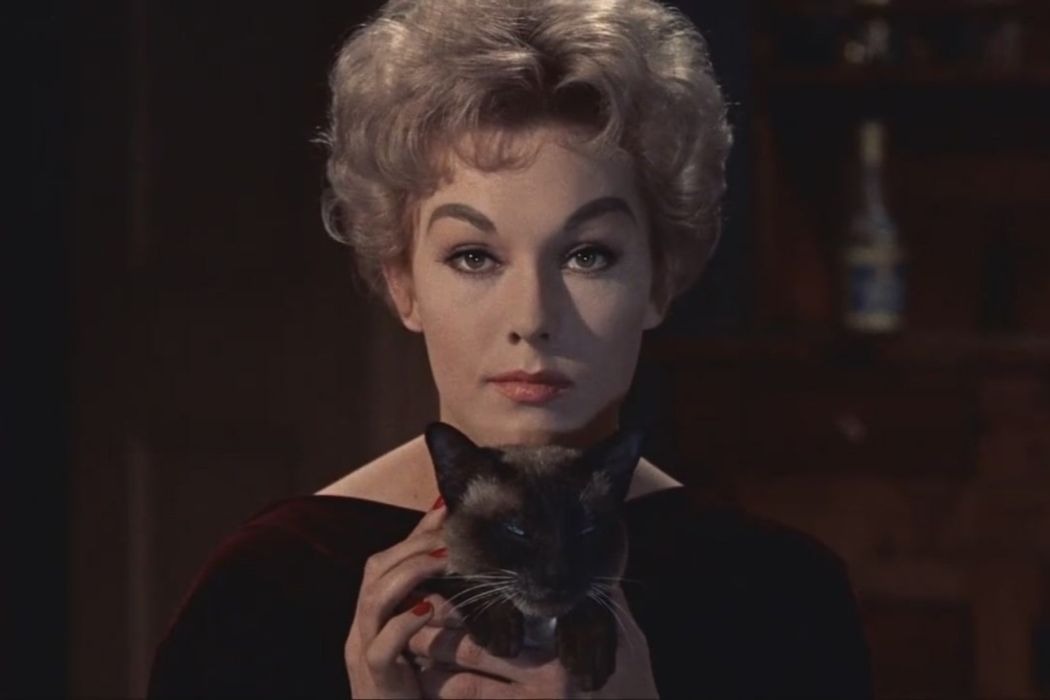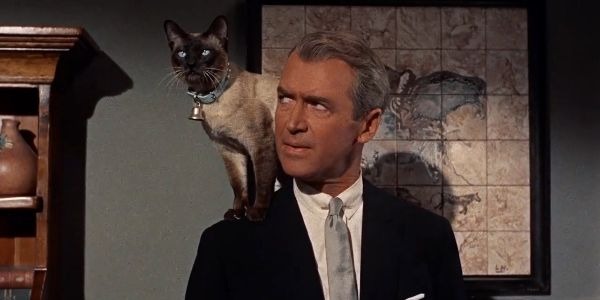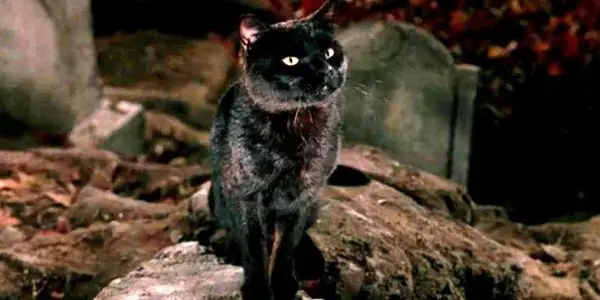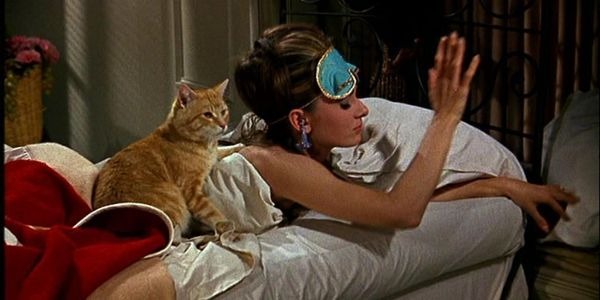Staff Inquiry: Cinema Is A Cat

Alex is a film addict, TV aficionado, and book lover.…
Cats. The obstinate, self-absorbed felines aren’t the most ideal actors, so most of cinema’s great pets have been of the canine persuasion. Still, people love cats so much that they’ve managed to grace the big screen plenty of times, whether portrayed by actual cats or CGI creations.
We here at Film Inquiry also love the mercurial beings, so for this month’s staff inquiry we’re taking a look at some of our favorite cats from cinema. And once you’ve checked out those, find us on twitter where many of us give updates on our real-life cats (at least I do, please come meet my Mr. Whiskers!).
Garrett Brown – All Of Cats (2019)

All my life, going to the movies has been a social experience. Even when I’m going solo, I can feel the energy between the seats, the camaraderie that accompanies a shared experience. Since lockdown, however, the closest I have come to something like this is using Zoom to watch Cats with friends in other cities.
To get it out there, let me begin by acknowledging that Cats is not a film of quality. At best, it is a nightmarish CGI fever dream that dwells in the uncanny valley. Not being a quality film though, does not mean that Cats is not delightful…
In the Zoom watch party, we compose our reactions to the extravagance in the chatbox. We may not all be in the same house, but we all shriek at the same time when Jennyanydots (Rebel Wilson) unzips her skin to reveal another skin underneath. We laugh at the absurdity of cats that constantly appear to be changing size, big enough to captain a boat, but smaller than a car. My friends might be far, but watching Cats reminds me how close we are at heart.
I love Cats for two reasons: first, it’s bonkers and campy, and as a musical theatre kid that is all I want in my life. Secondly, Cats is a reminder about the community aspect of film, that we can all gather together and collectively experience something wild and fun and then have time to discuss it afterwards. There is a reason theatres were starting to hold Rocky Horror Picture Show-style gatherings for Cats: film offers people the opportunity to experience the world together. It will be a while before we can gather in public again, but I cannot wait to bring Jellicle Cats into that new world.
Lee Jutton – Pyewacket From Bell, Book and Candle (1958)

As someone with a passing interest in witchcraft and a much more than passing interest in my cat, I often joke that he is my familiar. Truth is, apart from the one time I asked him to choose a tarot card from my deck and he somehow managed to land on one that could be interpreted as treats, I don’t think the magical arts are his forte. Still, it’s fun to pretend, especially when you see so many other felines performing fantastical acts in witch-centric cinema.
My personal favorite? Pyewacket, the Siamese belonging to Greenwich Village antique shop owner and witch Gillian Holroyd in the 1958 romantic comedy-drama Bell, Book and Candle. Gillian is played by Kim Novak, and her cat Pyewacket is (mostly) played by Kim Novak’s real-life cat of the same name. Conveniently, Pyewacket’s unusual name is fitting for such a film; it is the name of one of the familiar spirits of a witch accused by witchfinder general Matthew Hopkins in 1644.
In one of the film’s most memorable scenes, Gillian uses the powers of Pyewacket to bewitch her neighbor, Shep, played by Jimmy Stewart, into falling in love with her. Staring into the deep blue eyes of Pyewacket, it’s no wonder Shep becomes hypnotized!
Pyewacket continues to play a pivotal role in the film, running away and refusing to help Gillian curse Shep’s fiancee before returning to reunite Gillian and Shep at the end of the film, when they naturally realize that despite all of the magic swirling around them, their love is in fact very real. The movie itself is a whole lot of fun, with a supporting cast that includes Elsa Lanchester and Jack Lemmon as Gillian’s witchy extended family. But I have to say, despite the colorful collection of human characters, Pyewacket is my favorite.
Linsey Satterthwaite – Binx From Hocus Pocus (1993)

Hocus Pocus contains two of my greatest loves: Halloween and a fantastic film cat. It is hard to steal screen time from a scenery-chewing witchy Bette Midler, but Binx the cat is the real star of Hocus Pocus.
What is so great about this feline and his place in the narrative is that the notion of the black cat at Halloween is turned on its head. Instead of being the evil companion to a witch, Binx, who begins life as a human, is cursed and turned into an immortal black cat by the Sanderson sisters. He then commits his life to stopping the witches and, in turn, becomes their biggest foe. He provides the crucial knowledge to help the children defeat the evil sisters, and he delivers the pivotal final blow to the witches, sacrificing himself for the greater good.
What I also love about Binx is that he is a humble black cat, but he becomes one of cinema’s most unforgettable moggies. In a society that often favours prettier felines (black cats are predominately the last to be picked in shelters), it is majestic that he can be a true hero. And as someone who is the proud mother of a rescued black cat, it makes Binx’s entry into the canon of greatest cinematic cats all the more special.
Kristy Strouse – Jonesy From Alien (1979)

When I think about cats in film, the resilient orange Jonesy comes instantly to mind. This kitty is the only animal aboard the USCSS Nostromo in Ridley Scott’s 1979 science fiction/horror classic, and while not a main character, he’s woven into the story.
A cat aboard a spaceship filled with aliens? And he manages to survive? That’s a feline worth celebrating. The connection with Sigourney Weaver’s Ellen Ripley, the real hero of this film, makes his part even more memorable. By all accounts, he should be an easy meal for the xenomorph but isn’t.
In films, contact with animals and pets is always a meaningful part for me. It can either be a hindrance to the story or a worthy addition. The latter is especially true when they are introduced and their stories are wrapped up. Sometimes the whereabouts of the animal or their survival is either ambiguous or they have a quick end.
In the recent horror film Crawl the dog’s finality is paid mind too, something I respect. The same goes for Alien, as Ripley ensures that Jonesy isn’t left behind (even if some people might not risk grabbing the cat when they are fighting for survival), eventually going into hypersleep together. He even makes it to Aliens, the second in the franchise, and is consistently a comfort to Ellen throughout these traumatic events, showing the power these special four-legged friends can have.
Emily Wheeler – Duman From Kedi (2017)

The documentary Kedi is a cat lover’s dream. It gives a cat’s eye view of Istanbul’s unique relationship to their feline population, one where the cats roam free throughout the city and the people navigate around them. Seven cats were focused on, but only one stole my heart.
Duman is everything I love in cats, which also happens to be everything I hate in humans. He’s entitled, demanding, and when he looks at you, you can tell he always gets what he wants. Billed as the gentleman cat, he hangs out in an upscale neighborhood and paws at the window of a cafe until they bring him fine cheese and smoked turkey. They are delighted to serve him, just like I would be.
But I can’t because Duman is far away in Istanbul, a city that seems like my version of heaven. Someday I will visit, but for now I must settle for Kedi and my king Duman.
Tynan Yanaga – Cat From Breakfast at Tiffany’s (1961)

One of my mentors actually penned a film study called Cinema is a Cat (a play on Natsume Soseki’s I Am a Cat). If we can run with these ideas, often filmic felines are semiotic creatures. In a world of “Super Rats” who frequent the frames of Breakfast at Tiffany’s, Cat, played by furry celebrity Orangey, is not only Holly Golightly’s apartment mate but an embodiment of what she’s striving after. She doesn’t want to be owned – to be put in a cage – and as a result, she never gets close to anyone. It works for a time…
In the final scene, when she goes racing off into the rain, forlorn and poking around for the soaked tabby, not only does it reflect her attachment issues but also her need for companionship. The glitzy superficiality is shed for this ever-apparent vulnerability underneath. She and this cat are one and the same. They are not meant to be left to the elements of this world, out on their own.
Even as they struggle to live tethered to a name, they want to be known and loved. And as this is a rom-com, George Peppard stands by to wrap Audrey up in his embrace, the cat, now coddled in their warmth and affection. Thus, the cat is more than a character. The cat comes to represent the core of Holly Golightly herself. Not only can they be creatures of satire or symbolism but also (once in a “moon river”) conduits of pathos.
Those are some of our favorite cats from cinema. What are some of yours?
Does content like this matter to you?
Become a Member and support film journalism. Unlock access to all of Film Inquiry`s great articles. Join a community of like-minded readers who are passionate about cinema - get access to our private members Network, give back to independent filmmakers, and more.
Alex is a film addict, TV aficionado, and book lover. He's perfecting his cat dad energy.













